From Wikipedia, the free encyclopedia.
The decade of 1880 featured the 1880-1889 Atlantic hurricane seasons. While data for every storm that occurred is unavailable, some parts of the coastline were populated enough to give data of hurricane occurrences. Each season was an ongoing event in the annual cycle of tropical cyclone formation. They officially began on June 1 and ended on November 30.
1880 Atlantic Hurricane Season
1880 Atlantic hurricane season
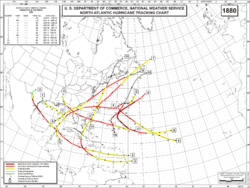
Season summary map
|
|
| First storm formed: |
{{{first storm formed}}} |
| Last storm dissipated: |
{{{last storm dissipated}}} |
| Strongest storm: |
{{{strongest storm}}} |
| Total storms: |
{{{total storms}}} |
| Major storms (Cat. 3+) |
{{{major storms}}} |
| Total damages: |
{{{total damages}}} |
| Total fatalites: |
{{{total fatalities}}} |
[[List of {{{basin}}} seasons|{{{basin}}} seasons]]
{{{five seasons}}} |
|
The second storm of the season formed over the northeastern Lesser Antilles on August 4th. It moved westward through the Caribbean Sea, reaching hurricane strength on the 6th east of Jamaica. It passed to the south of the island, and strengthened further to a Category 2 hurricane, but a landfall on the Yucatan Peninsula weakened it to a tropical storm. While moving across the Gulf, the storm intensified back to a hurricane on the 11th, followed by a period of rapid intensification to a 150 M.P.H. hurricane. It made landfall near Brownsville, Texas on the 13th, and dissipated rapidly over land on the 14th. It caused 30 deaths near the Yucatan Peninsula.
The third storm of the season began its life just northeast of Barbados on August 15th. It moved quickly through the islands, and reached hurricane strength on the 18th. It passed over Jamaica the next day, followed by a Cuban landfall later that day. The circulation was disrupted over Cuba, and dissipated on the 20th over the Bahamas. It caused 30 deaths.
The 4th storm of the year started over the Central North Atlantic on August 24th. It moved steadily westward, reaching hurricane strength on the 26th. The next day it reached its peak of 100 M.P.H. winds. The storm would retain that intensity until its landfall near St. Augustine, Florida on the 29th. It passed over the peninsula, weakening to a tropical storm, but managed to become a hurricane prior to its 2nd Florida landfall on the 31st. The storm continued northwestward, dissipating over Mississippi on the 1st. It caused 68 deaths.
1881 Atlantic Hurricane Season
1881 Atlantic hurricane season
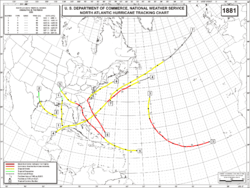
Season summary map
|
|
| First storm formed: |
{{{first storm formed}}} |
| Last storm dissipated: |
{{{last storm dissipated}}} |
| Strongest storm: |
{{{strongest storm}}} |
| Total storms: |
{{{total storms}}} |
| Major storms (Cat. 3+) |
{{{major storms}}} |
| Total damages: |
{{{total damages}}} |
| Total fatalites: |
{{{total fatalities}}} |
[[List of {{{basin}}} seasons|{{{basin}}} seasons]]
{{{five seasons}}} |
|
A westward moving tropical storm moved through the northeastern Lesser Antilles on August 22nd. It reached hurricane strength on the 24th, and continued northwestward until its Georgia landfall on the 27th as a Category 2 hurricane. It moved inland, dissipating on the 29th over northwestern Mississippi, resulting in around 700 deaths.
A hurricane existed north of Hispanola on September 7th. It moved northwestward, reaching a peak of 100 mph prior to hitting southern North Carolina. It weakened to a tropical storm over land, bringing heavy, yet benificial, rain to the mid-Atlantic. It moved out to sea, dissipating near Cape Cod.
1882 Atlantic Hurricane Season
1882 Atlantic hurricane season
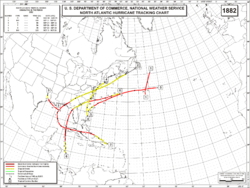
Season summary map
|
|
| First storm formed: |
{{{first storm formed}}} |
| Last storm dissipated: |
{{{last storm dissipated}}} |
| Strongest storm: |
{{{strongest storm}}} |
| Total storms: |
{{{total storms}}} |
| Major storms (Cat. 3+) |
{{{major storms}}} |
| Total damages: |
{{{total damages}}} |
| Total fatalites: |
{{{total fatalities}}} |
[[List of {{{basin}}} seasons|{{{basin}}} seasons]]
{{{five seasons}}} |
|
A tropical cyclone moved across Cuba and the Gulf of Mexico before striking the Florida panhandle as a Category 3 hurricane on September 10th. It crossed Georgia, the Carolinas, and went offshore near the lower end of Chesapeake Bay. It caused a landslide, but no deaths were reported.
A tropical storm formed north of the Bahamas on September 21st. It moved north into North Carolina, landfalling near Cape Lookout. It moved over the mid-Atlantic coast, bringing nearly a foot of rain in some areas. It dissipated on the 24th near Long Island.
On October 5th, a tropical storm formed in the western Caribbean Sea. It moved northward, and as it approached the coast of Cuba, it rapidly intensified to a 140 mph major hurricane. It weakened greatly over the island, never recovering while moving northward over the Gulf of Mexico. It crossed Florida and went out to sea, dissipating on the 15th. Its renmants brought heavy rain to Labrador, and left 140 casualties in its path.
1883 Atlantic Hurricane Season
1883 Atlantic hurricane season
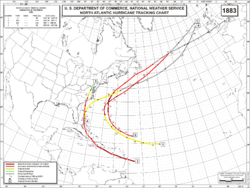
Season summary map
|
|
| First storm formed: |
{{{first storm formed}}} |
| Last storm dissipated: |
{{{last storm dissipated}}} |
| Strongest storm: |
{{{strongest storm}}} |
| Total storms: |
{{{total storms}}} |
| Major storms (Cat. 3+) |
{{{major storms}}} |
| Total damages: |
{{{total damages}}} |
| Total fatalites: |
{{{total fatalities}}} |
[[List of {{{basin}}} seasons|{{{basin}}} seasons]]
{{{five seasons}}} |
|
A hurricane recurved to the northeast over the western Atlantic in late August. It moved past Newfoundland on August 26th, causing 80 deaths from swells.
A major hurricane moved through the Lesser Antilles on September 4th. It crossed Hispanola, weakening to a minimal hurricane. It restrengthened as it passed the Bahamas, and struck North Carolina as a Category 2 hurricane on the 11th. It dissipated over Virginia on the 13th, not after causing 106 deaths.
1884 Atlantic Hurricane Season
1884 Atlantic hurricane season

Season summary map
|
|
| First storm formed: |
{{{first storm formed}}} |
| Last storm dissipated: |
{{{last storm dissipated}}} |
| Strongest storm: |
{{{strongest storm}}} |
| Total storms: |
{{{total storms}}} |
| Major storms (Cat. 3+) |
{{{major storms}}} |
| Total damages: |
{{{total damages}}} |
| Total fatalites: |
{{{total fatalities}}} |
[[List of {{{basin}}} seasons|{{{basin}}} seasons]]
{{{five seasons}}} |
|
The third storm of the season formed on September 10th off the coast of Florida. It moved northwestward, hitting the coast of Georgia the next day. It weakened over land, but did a U-Turn and restrengthened over the Atlantic Ocean. Moving southeastward, it reached favorable conditions, where, after looping, it became a hurricane on the 15th. The hurricane moved rapidly northeastward, passing Bermuda to the south and becoming extratropical on the 20th.
1885 Atlantic Hurricane Season
1885 Atlantic hurricane season

Season summary map
|
|
| First storm formed: |
{{{first storm formed}}} |
| Last storm dissipated: |
{{{last storm dissipated}}} |
| Strongest storm: |
{{{strongest storm}}} |
| Total storms: |
{{{total storms}}} |
| Major storms (Cat. 3+) |
{{{major storms}}} |
| Total damages: |
{{{total damages}}} |
| Total fatalites: |
{{{total fatalities}}} |
[[List of {{{basin}}} seasons|{{{basin}}} seasons]]
{{{five seasons}}} |
|
A tropical storm was first observed north of Puerto Rico on August 21st. It moved to the west, hitting the Bahamas. It paralleled the coast of Florida and Georgia, remaining offshore until its South Carolina landfall on the 25th as a major hurricane. It caused 25 deaths.
1886 Atlantic Hurricane Season
1886 Atlantic hurricane season

Season summary map
|
|
| First storm formed: |
{{{first storm formed}}} |
| Last storm dissipated: |
{{{last storm dissipated}}} |
| Strongest storm: |
{{{strongest storm}}} |
| Total storms: |
{{{total storms}}} |
| Major storms (Cat. 3+) |
{{{major storms}}} |
| Total damages: |
{{{total damages}}} |
| Total fatalites: |
{{{total fatalities}}} |
[[List of {{{basin}}} seasons|{{{basin}}} seasons]]
{{{five seasons}}} |
|
The 1886 Atlantic Hurricane Season began with 3 June U.S. landfalling hurricanes.
The Indianola Hurricane of 1886 caused great damage in Texas during late August.
A tropical storm was observed in the northwest Caribbean Sea on October 8th. It moved to the northwest, reaching major hurricane strength in the Gulf of Mexico on the 11th. Late on the 12th, the hurricane made landfall near the border between Louisiana and Texas. It caused 175-200 deaths due to the heavy rainfall and storm surge.
1887 Atlantic Hurricane Season
1887 Atlantic hurricane season
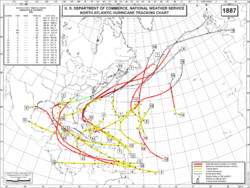
Season summary map
|
|
| First storm formed: |
{{{first storm formed}}} |
| Last storm dissipated: |
{{{last storm dissipated}}} |
| Strongest storm: |
{{{strongest storm}}} |
| Total storms: |
{{{total storms}}} |
| Major storms (Cat. 3+) |
{{{major storms}}} |
| Total damages: |
{{{total damages}}} |
| Total fatalites: |
{{{total fatalities}}} |
[[List of {{{basin}}} seasons|{{{basin}}} seasons]]
{{{five seasons}}} |
|
While the 1887 season was very active, having 19 tropical storms, most of them were weak or went out to sea. The season's 2 major hurricanes, both following a very similar Cape Verde-type hurricane path, brushed the Outer Banks, but remained offshore. Several tropical storms or minimal hurricanes made landfall, but only one, a weak tropical storm, caused any deaths.
1888 Atlantic Hurricane Season
1888 Atlantic hurricane season
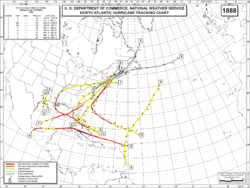
Season summary map
|
|
| First storm formed: |
{{{first storm formed}}} |
| Last storm dissipated: |
{{{last storm dissipated}}} |
| Strongest storm: |
{{{strongest storm}}} |
| Total storms: |
{{{total storms}}} |
| Major storms (Cat. 3+) |
{{{major storms}}} |
| Total damages: |
{{{total damages}}} |
| Total fatalites: |
{{{total fatalities}}} |
[[List of {{{basin}}} seasons|{{{basin}}} seasons]]
{{{five seasons}}} |
|
A tropical storm was first detected near the Bahamas on August 14th. As it neared the coast of Florida, it strengthened to a Category 3 hurricane, but weakened over land. Once over the Gulf of Mexico, it agained strengthened, this time to a Category 2. It made landfall on Louisiana on the 19th, causing storm surge and heavy rain, New Orleans itself receiving nearly a foot of rain. The storm recurved over the Ohio Valley and brought more rain, this time to the Mid-Atlantic region where it caused 3 deaths. In all, this storm caused $2.7 million in damage.
On August 31st, a tropical storm was observed northeast of the Lesser Antilles. It moved westward, strengthening to a hurricane later that day. As it continued to strengthen, it brought heavy rain over Puerto Rico, the Turks and Caicos Islands, and Cuba. On the 3rd, it reached its peak of 130 mph but land interaction with Cuba weakened it to a minimal hurricane. It crossed the island and the Yucatan Channel, reaching the northeast coast of the Yucatan Peninsula on the 6th. After weakening to a tropical storm, it restrengthened to a Category 2 hurricane while moving southwestward in the Bay of Campeche, but it dissipated after its Veracruz landfall on the 8th. It caused 921 deaths.
1889 Atlantic Hurricane Season
1889 Atlantic hurricane season

Season summary map
|
|
| First storm formed: |
{{{first storm formed}}} |
| Last storm dissipated: |
{{{last storm dissipated}}} |
| Strongest storm: |
{{{strongest storm}}} |
| Total storms: |
{{{total storms}}} |
| Major storms (Cat. 3+) |
{{{major storms}}} |
| Total damages: |
{{{total damages}}} |
| Total fatalites: |
{{{total fatalities}}} |
[[List of {{{basin}}} seasons|{{{basin}}} seasons]]
{{{five seasons}}} |
|
A hurricane formed on September 1st, east of Barbados. It moved northwestward, becoming a 100 mph while crossing Puerto Rico. From September 9th to the 12th it caused flooding and storm surge to the mid Atlantic as it stalled off the coast, causing 40 deaths.
On September 12th, a tropical storm formed over the northern Lesser Antilles. It moved westward across the northern Caribbean, and on the 18th, hit the eastern Yucatan Peninsula as a Category 2 hurricane. After weakening over land, it turned northward, where it again strengthened to a Cat. 2. While moving northeastward over the Gulf of Mexico, it weakened, and hit near Pensacola, Florida on the 23rd. Its minimal intensity at its U.S. landfall resulted in little damage, but Yucatan fared a little worse. No damage was severe.
External links











